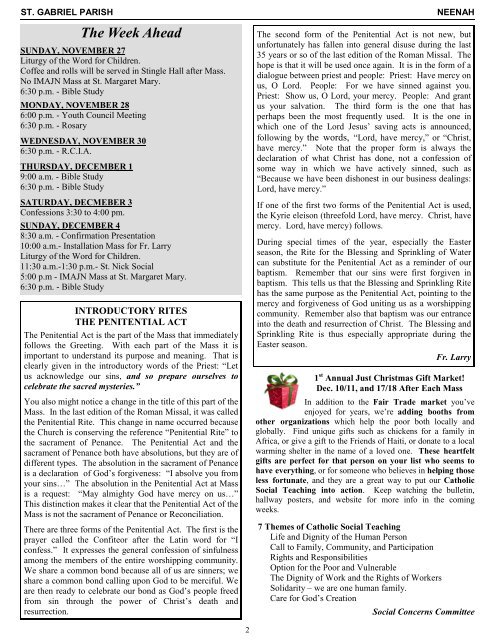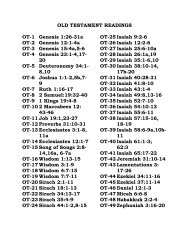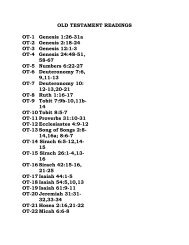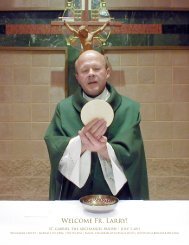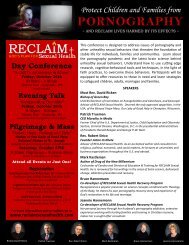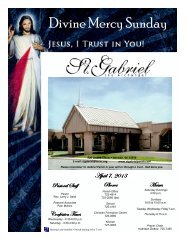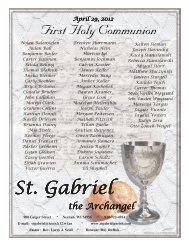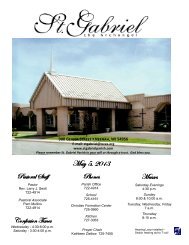St. Gabriel the Archangel - St Gabriel Parish
St. Gabriel the Archangel - St Gabriel Parish
St. Gabriel the Archangel - St Gabriel Parish
Create successful ePaper yourself
Turn your PDF publications into a flip-book with our unique Google optimized e-Paper software.
ST. GABRIEL PARISH<br />
The Week Ahead<br />
SUNDAY, NOVEMBER 27<br />
Liturgy of <strong>the</strong> Word for Children.<br />
Coffee and rolls will be served in <strong>St</strong>ingle Hall after Mass.<br />
No IMAJN Mass at <strong>St</strong>. Margaret Mary.<br />
6:30 p.m. - Bible <strong>St</strong>udy<br />
MONDAY, NOVEMBER 28<br />
6:00 p.m. - Youth Council Meeting<br />
6:30 p.m. - Rosary<br />
WEDNESDAY, NOVEMBER 30<br />
6:30 p.m. - R.C.I.A.<br />
THURSDAY, DECEMBER 1<br />
9:00 a.m. - Bible <strong>St</strong>udy<br />
6:30 p.m. - Bible <strong>St</strong>udy<br />
SATURDAY, DECMEBER 3<br />
Confessions 3:30 to 4:00 pm.<br />
SUNDAY, DECEMBER 4<br />
8:30 a.m. - Confirmation Presentation<br />
10:00 a.m.- Installation Mass for Fr. Larry<br />
Liturgy of <strong>the</strong> Word for Children.<br />
11:30 a.m.-1:30 p.m.- <strong>St</strong>. Nick Social<br />
5:00 p.m - IMAJN Mass at <strong>St</strong>. Margaret Mary.<br />
6:30 p.m. - Bible <strong>St</strong>udy<br />
INTRODUCTORY RITES<br />
THE PENITENTIAL ACT<br />
The Penitential Act is <strong>the</strong> part of <strong>the</strong> Mass that immediately<br />
follows <strong>the</strong> Greeting. With each part of <strong>the</strong> Mass it is<br />
important to understand its purpose and meaning. That is<br />
clearly given in <strong>the</strong> introductory words of <strong>the</strong> Priest: “Let<br />
us acknowledge our sins, and so prepare ourselves to<br />
celebrate <strong>the</strong> sacred mysteries.”<br />
You also might notice a change in <strong>the</strong> title of this part of <strong>the</strong><br />
Mass. In <strong>the</strong> last edition of <strong>the</strong> Roman Missal, it was called<br />
<strong>the</strong> Penitential Rite. This change in name occurred because<br />
<strong>the</strong> Church is conserving <strong>the</strong> reference “Penitential Rite” to<br />
<strong>the</strong> sacrament of Penance. The Penitential Act and <strong>the</strong><br />
sacrament of Penance both have absolutions, but <strong>the</strong>y are of<br />
different types. The absolution in <strong>the</strong> sacrament of Penance<br />
is a declaration of God’s forgiveness: “I absolve you from<br />
your sins…” The absolution in <strong>the</strong> Penitential Act at Mass<br />
is a request: “May almighty God have mercy on us…”<br />
This distinction makes it clear that <strong>the</strong> Penitential Act of <strong>the</strong><br />
Mass is not <strong>the</strong> sacrament of Penance or Reconciliation.<br />
There are three forms of <strong>the</strong> Penitential Act. The first is <strong>the</strong><br />
prayer called <strong>the</strong> Confiteor after <strong>the</strong> Latin word for “I<br />
confess.” It expresses <strong>the</strong> general confession of sinfulness<br />
among <strong>the</strong> members of <strong>the</strong> entire worshipping community.<br />
We share a common bond because all of us are sinners; we<br />
share a common bond calling upon God to be merciful. We<br />
are <strong>the</strong>n ready to celebrate our bond as God’s people freed<br />
from sin through <strong>the</strong> power of Christ’s death and<br />
resurrection.<br />
NEENAH<br />
The second form of <strong>the</strong> Penitential Act is not new, but<br />
unfortunately has fallen into general disuse during <strong>the</strong> last<br />
35 years or so of <strong>the</strong> last edition of <strong>the</strong> Roman Missal. The<br />
hope is that it will be used once again. It is in <strong>the</strong> form of a<br />
dialogue between priest and people: Priest: Have mercy on<br />
us, O Lord. People: For we have sinned against you.<br />
Priest: Show us, O Lord, your mercy. People: And grant<br />
us your salvation. The third form is <strong>the</strong> one that has<br />
perhaps been <strong>the</strong> most frequently used. It is <strong>the</strong> one in<br />
which one of <strong>the</strong> Lord Jesus’ saving acts is announced,<br />
following by <strong>the</strong> words, “Lord, have mercy,” or “Christ,<br />
have mercy.” Note that <strong>the</strong> proper form is always <strong>the</strong><br />
declaration of what Christ has done, not a confession of<br />
some way in which we have actively sinned, such as<br />
“Because we have been dishonest in our business dealings:<br />
Lord, have mercy.”<br />
If one of <strong>the</strong> first two forms of <strong>the</strong> Penitential Act is used,<br />
<strong>the</strong> Kyrie eleison (threefold Lord, have mercy. Christ, have<br />
mercy. Lord, have mercy) follows.<br />
During special times of <strong>the</strong> year, especially <strong>the</strong> Easter<br />
season, <strong>the</strong> Rite for <strong>the</strong> Blessing and Sprinkling of Water<br />
can substitute for <strong>the</strong> Penitential Act as a reminder of our<br />
baptism. Remember that our sins were first forgiven in<br />
baptism. This tells us that <strong>the</strong> Blessing and Sprinkling Rite<br />
has <strong>the</strong> same purpose as <strong>the</strong> Penitential Act, pointing to <strong>the</strong><br />
mercy and forgiveness of God uniting us as a worshipping<br />
community. Remember also that baptism was our entrance<br />
into <strong>the</strong> death and resurrection of Christ. The Blessing and<br />
Sprinkling Rite is thus especially appropriate during <strong>the</strong><br />
Easter season.<br />
Fr. Larry<br />
1 st Annual Just Christmas Gift Market!<br />
Dec. 10/11, and 17/18 After Each Mass<br />
In addition to <strong>the</strong> Fair Trade market you’ve<br />
enjoyed for years, we’re adding booths from<br />
o<strong>the</strong>r organizations which help <strong>the</strong> poor both locally and<br />
globally. Find unique gifts such as chickens for a family in<br />
Africa, or give a gift to <strong>the</strong> Friends of Haiti, or donate to a local<br />
warming shelter in <strong>the</strong> name of a loved one. These heartfelt<br />
gifts are perfect for that person on your list who seems to<br />
have everything, or for someone who believes in helping those<br />
less fortunate, and <strong>the</strong>y are a great way to put our Catholic<br />
Social Teaching into action. Keep watching <strong>the</strong> bulletin,<br />
hallway posters, and website for more info in <strong>the</strong> coming<br />
weeks.<br />
7 Themes of Catholic Social Teaching<br />
Life and Dignity of <strong>the</strong> Human Person<br />
Call to Family, Community, and Participation<br />
Rights and Responsibilities<br />
Option for <strong>the</strong> Poor and Vulnerable<br />
The Dignity of Work and <strong>the</strong> Rights of Workers<br />
Solidarity – we are one human family.<br />
Care for God’s Creation<br />
Social Concerns Committee<br />
2


